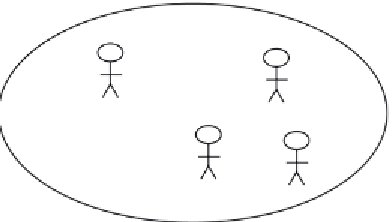what-when-how
In Depth Tutorials and Information
a very technical and specific section of code, or the expert programmer might have
personal reasons for not wanting to fulfill that particular request. Whatever the
reason, the expert programmer should not be forced into fulfilling any information
seeker's request if he or she does not so desire.
he type of thinking that the designers of the STeP_IN framework have for build-
ing this interface is an outside-the-box type of thinking. It uses a very abstract type
of thought process to try and fully cover all bases of the information seeking that the
interface and framework is built for. To conceptualize the way a collaborative soft-
ware development project is completed, the designers speak of a software project as
a “socio-technical information space” [3]. Figure 15.5 shows the information space,
which includes three main components: code, documents, and programmers.
he above figure is a good representation of the tools the programmer has avail-
able. It was important to the designers of the STeP_IN framework to visualize the
information space that a programmer had readily available to him or her. he next
hurdle to cross was the explanation of all the relationships between the three indi-
vidual components.
A code-code relationship means that the code is connected in some way. his
idea has been addressed somewhat in earlier sections of this document. Two sec-
tions of code can be either functionally dependent, data dependent, or both if
they are said to be connected. A code-document relationship means one of two
things: either the code implements an idea that is described in the document, or
Programmer
Document
Code
Knowledge
Current Assignment
Figure 15.5
Sociotechnical information space for a programmer. (From Ye,
Yunwenetal.ASocio-TechnicalFrameworkforSupportingProgrammers.
6th Joint
Meeting of the European Software Engineering Conference and the Symposium
on the Foundations of Software Engineering (2007)
:Pages351-360.)

















